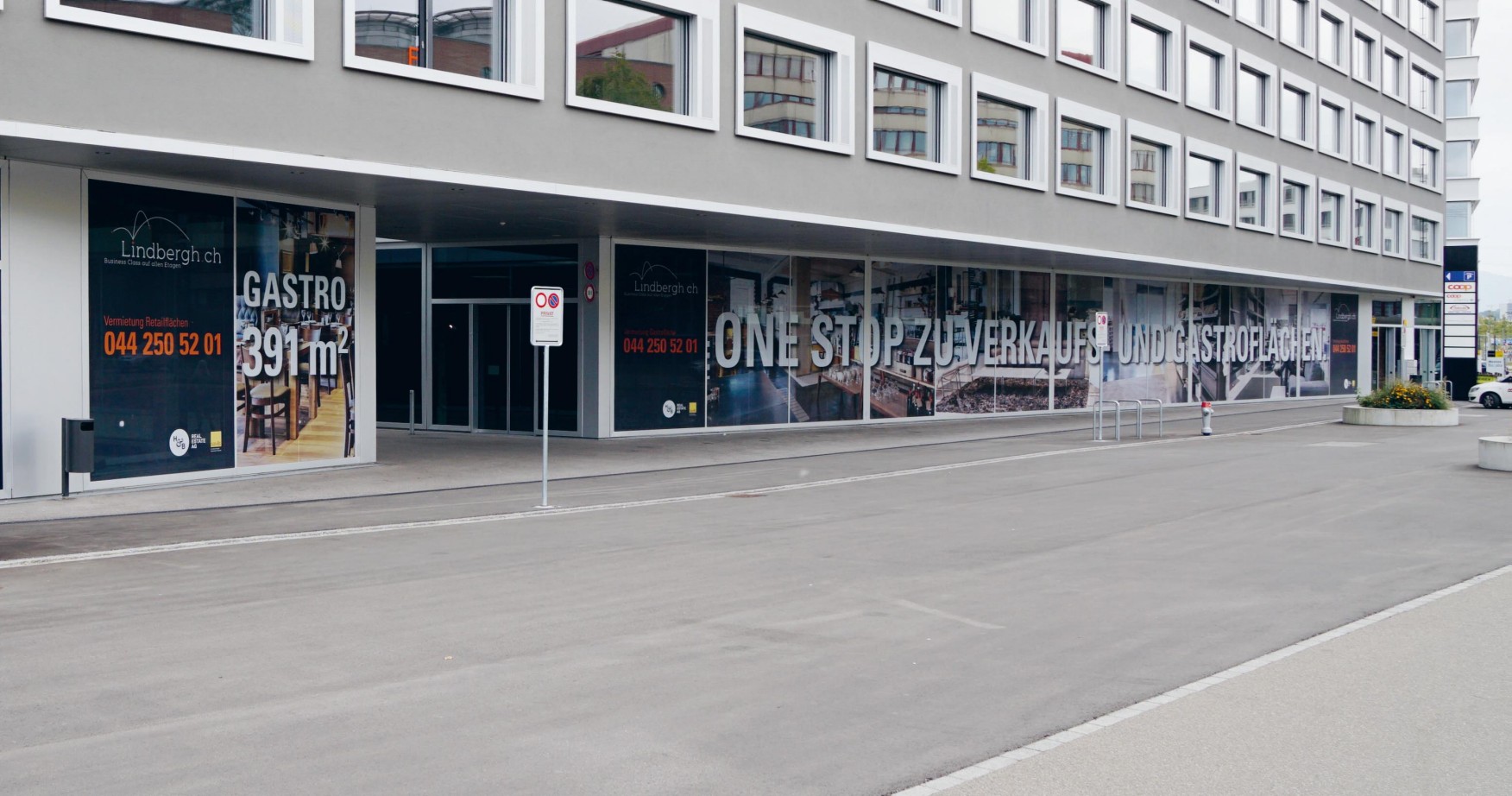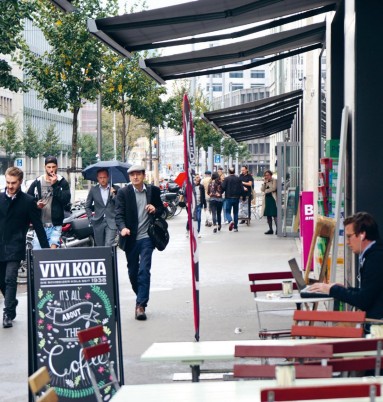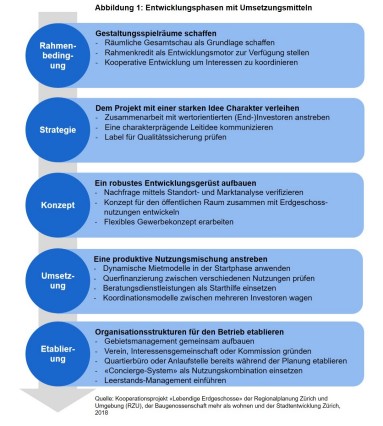Living Ground Floors: Guide and Case Studies
January 28, 2019 - Simon Keller
The desire for busy and attractive ground floors is widespread. In reality, the development and management of ground floors with public-oriented uses is proving increasingly difficult due to structural change in the retail trade and the oversupply of ground floor space. Innovative approaches that take into account today's shopping behaviour and the current everyday life of many people are therefore in demand. This guide, which has been prepared on the basis of nine practical examples, contributes to this.

Stroll through busy streets and alleys in the city, do your everyday shopping in a shop around the corner or enjoy a cappuccino in a café with full shopping bags after shopping. This ideal of the city and shopping is confronted with a harsh reality. Since 2010, around 6,000 shops in Switzerland have closed, as the "retail pope" Markus Hochreutener of GfK emphasizes. Looking to the future, Freddy Hasenmaile warned as early as 2015 that a third of the approximately 50,000 shops in Switzerland were at risk. The city of Zurich is likely to be less affected due to its centrality, but the vacancy rate of sales areas has also grown in the Limmat city (increase from 3,000m2 (2016) to 10,000m2 (2017)).
The density of cities and towns is still considered an important prerequisite for sufficient demand in the retail trade, but this is no longer sufficient. Due to the increasing mobility of the population, shopping first shifted to shopping centers outside the city and later to mobility hubs such as train stations (the turnover of the five largest Swiss stations in 2017 was around CHF 1 billion), airports or petrol stations. They benefit from extended opening hours and high frequencies.
Reduction of demand for space due to online trading and foreign purchasing
Brick-and-mortar stores in Swiss municipalities are also facing increasing competition from shopping abroad. In 2016, the Swiss population bought around CHF 10 billion abroad, which accounts for around 11% of retail sales in Switzerland (2016: CHF 92.2 billion). It must be emphasized that foreign purchasing does not only consist of shopping tourism due to the "ennet" franc strength of the border, for example in Constance or Waldshut. Almost half of foreign purchases (2016: 44%) take place during holidays or on business trips, which is an expression of our globalized leisure and professional world.
One of the biggest challenges for the retail trade is the much-discussed online trade. A total market share of around 9% (2017) does not yet seem like much, but its rapid growth of 5 – 10% in recent years must be taken into account. This is expected to continue in the coming years. The online retailer Zalando has replaced H&M as the largest clothing supplier in Switzerland within a few years, without Zalando having employed its own employees in Switzerland.
Expansion of the supply of space due to construction activity

The developments described led to a decline in demand for retail space. At the same time, due to the great investment incentives triggered by population growth and investment pressure among investors, a large number of (residential) buildings have been built in the greater Zurich area in recent years. For their ground floors, shops and other public-oriented uses are sought, even if the necessary demand is not (yet) given. As a result, the market for retail space is saturated in many places.
Requirements of the public sector regarding public-oriented use of the ground floor must therefore be carefully considered.
Ground floor as an independent planning and management task
Busy ground floors are no longer a matter of course. The public sector as well as the developers and investors are challenged: they have to find a location-adapted approach to the development and make a great effort. Ground floors have to be coordinated with the outdoor space and the demand for uses is changing rapidly due to the structural change in the retail trade. In the future, the ground floor must be understood much more as an independent planning and management task.
Learnings from current case studies
In a joint project, regional planning Zurich and the surrounding area, the building cooperative mehr als wohnen and the urban development of Zurich have examined the functioning of nine current construction projects with ground floor uses from the Zurich region and from Vienna. The projects are characterized by the fact that they have different location qualities and chose different approaches to development and design.
The learnings from the projects, which come directly from the practical experience of the participants, give an insight into the diversity and complexity of the ground floor topic. The Hunziker area of the cooperative more than living was about the importance of non-commercial common spaces. At the Opfiker Glattpark, the difficult conditions for achieving the necessary frequencies represented the greatest challenge.
At the Kloten Centre, the demand assessment was helpful for a successful ground floor development due to the developed strategy for interior densification. In addition, financial advances from the public sector prove to be an effective means of initiating the development of areas with ground floor uses.
In the case of cooperation or division of tasks for the use of the ground floor with several investors, the case studies show various possibilities. In the case of the non-profit property developers in Zurich-Manegg, the use of the ground floor was regulated by means of contracts between the investors, while an association was founded specifically for this purpose at the storage site in Winterthur. And at Seestadt Aspern in Vienna, a company specializing in shopping centers rents the ground floors of all investors on a long-term basis and rents them on.
Europa-Allee in Zurich showed that during the long development and construction period, a staggered rent structure for already opened shops makes sense. In the case of the replacement of the Friesenberg district centre, the locally limited demand posed a challenge in being able to realise a contemporary local supply.
Guidelines for the public sector, developers and investors
The case studies served as the basis for this guide. This is intended to serve as a checklist for the public sector as well as for developers and investors. The guideline lists five project development phases so that the topic of the ground floors can be taken into account in the entire planning and management process. The following points prove to be particularly important:
On the basis of a spatial overview, scope for action must be explored. A cooperative approach to coordinate interests helps
A concise, location-based guiding idea for the project serves as orientation and motivation for the participants. The ground floor uses must be embedded in the overall guiding principle.
A location and market analysis serves as the basis for a robust commercial concept that can react flexibly to changes.
When implementing projects with several investors , coordination models for the ground floors should be sought. This improves the opportunities of the commercial concept and distributes the risks among investors.
Once the project is in operation, organisational structures must be set up that promote active exchange and contact between owners, traders and residents.
The guidelines explain the individual development phases (see Figure 1) in detail and list concrete means of implementation. The structure in development phases is to be understood as a rough orientation and the listed means of implementation are to be understood as a pool of possibilities. Both must always be adapted to the respective circumstances and location. We hope that this guide will contribute to living ground floors.
More information
"Retail in Transition: Scenarios for the Retail Trade and the Impact on the City of Zurich"
"Structural Change in the Retail Trade", project of the Metropolitan Conference Zurich together with the IG Detailhandel Schweiz and the Swiss Retail Federation
Ground floors are to a significant extent enlivened by the retail trade. However, this is undergoing structural change, which Zurich's urban development is dealing with in the following two projects:
